The Hunt For New Worlds Continues With TESS
The Hunt for New Worlds Continues with TESS
We're getting ready to start our next mission to find new worlds! The Transiting Exoplanet Survey Satellite (TESS) will find thousands of planets beyond our solar system for us to study in more detail. It's preparing to launch from our Kennedy Space Center at Cape Canaveral in Florida.

Once it launches, TESS will look for new planets that orbit bright stars relatively close to Earth. We're expecting to find giant planets, like Jupiter, but we're also predicting we'll find Earth-sized planets. Most of those planets will be within 300 light-years of Earth, which will make follow-up studies easier for other observatories.

TESS will find these new exoplanets by looking for their transits. A transit is a temporary dip in a star's brightness that happens with predictable timing when a planet crosses between us and the star. The information we get from transits can tell us about the size of the planet relative to the size of its star. We've found nearly 3,000 planets using the transit method, many with our Kepler space telescope. That's over 75% of all the exoplanets we've found so far!

TESS will look at nearly the entire sky (about 85%) over two years. The mission divides the sky into 26 sectors. TESS will look at 13 of them in the southern sky during its first year before scanning the northern sky the year after.

What makes TESS different from the other planet-hunting missions that have come before it? The Kepler mission (yellow) looked continually at one small patch of sky, spotting dim stars and their planets that are between 300 and 3,000 light-years away. TESS (blue) will look at almost the whole sky in sections, finding bright stars and their planets that are between 30 and 300 light-years away.

TESS will also have a brand new kind of orbit (visualized below). Once it reaches its final trajectory, TESS will finish one pass around Earth every 13.7 days (blue), which is half the time it takes for the Moon (gray) to orbit. This position maximizes the amount of time TESS can stare at each sector, and the satellite will transmit its data back to us each time its orbit takes it closest to Earth (orange).

Kepler's goal was to figure out how common Earth-size planets might be. TESS's mission is to find exoplanets around bright, nearby stars so future missions, like our James Webb Space Telescope, and ground-based observatories can learn what they're made of and potentially even study their atmospheres. TESS will provide a catalog of thousands of new subjects for us to learn about and explore.

The TESS mission is led by MIT and came together with the help of many different partners. Learn more about TESS and how it will further our knowledge of exoplanets, or check out some more awesome images and videos of the spacecraft. And stay tuned for more exciting TESS news as the spacecraft launches!
Watch the Launch!
*April 16 Update*
Launch teams are standing down today to conduct additional Guidance Navigation and Control analysis, and teams are now working towards a targeted launch of the Transiting Exoplanet Survey Satellite (TESS) on Wednesday, April 18. The TESS spacecraft is in excellent health, and remains ready for launch. TESS will launch on a Falcon 9 rocket from Space Launch Complex 40 at Cape Canaveral Air Force Station in Florida.
For more information and updates, visit: https://blogs.nasa.gov/tess/
Live Launch Coverage!
TESS is now slated to launch on Wednesday, April 18 on a SpaceX Falcon 9 rocket from our Kennedy Space Center in Florida.
Watch HERE.
Make sure to follow us on Tumblr for your regular dose of space: http://nasa.tumblr.com
More Posts from Nasa and Others
Which is scarier? Launch VS re-entry?
What's a SPOC? Isn't that a star trek character?
Hearing a lot about ocean worlds today? Let’s dive in and see what this news is all about...
We once thought oceans made our planet unique, but we’re now coming to realize that ‘ocean worlds’ are all around us.
Two veteran NASA missions are providing new details about icy, ocean-bearing moons of Jupiter and Saturn, further heightening the scientific interest of these and other ‘ocean worlds’ in our solar system and beyond. The findings are presented in papers published Thursday by researchers with our Cassini mission to Saturn and Hubble Space Telescope.
Make sure to follow us on Tumblr for your regular dose of space: http://nasa.tumblr.com
SPACE: A Global Frontier
Space is a global frontier. That’s why we partner with nations all around the world to further the advancement of science and to push the boundaries of human exploration. With international collaboration, we have sent space telescopes to observe distant galaxies, established a sustainable, orbiting laboratory 254 miles above our planet’s surface and more! As we look forward to the next giant leaps in space exploration with our Artemis lunar exploration program, we will continue to go forth with international partnerships!
Teamwork makes the dream work. Here are a few of our notable collaborations:
Artemis Program

Our Artemis lunar exploration program will send the first woman and the next man to the Moon by 2024. Using innovative technologies and international partnerships, we will explore more of the lunar surface than ever before and establish sustainable missions by 2028.
During these missions, the Orion spacecraft will serve as the exploration vehicle that will carry the crew to space, provide emergency abort capability and provide safe re-entry from deep space return velocities. The European Service Module, provided by the European Space Agency, will serve as the spacecraft’s powerhouse and supply it with electricity, propulsion, thermal control, air and water in space.

The Gateway, a small spaceship that will orbit the Moon, will be a home base for astronauts to maintain frequent and sustainable crewed missions to the lunar surface. With the help of a coalition of nations, this new spaceship will be assembled in space and built within the next decade.
Gateway already has far-reaching international support, with 14 space agencies agreeing on its importance in expanding humanity's presence on the Moon, Mars and deeper into the solar system.
International Space Station

The International Space Station (ISS) is one of the most ambitious international collaborations ever attempted. Launched in 1998 and involving the U.S., Russia, Canada, Japan and the participating countries of the European Space Agency — the ISS has been the epitome of global cooperation for the benefit of humankind. The largest space station ever constructed, the orbital laboratory continues to bring together international flight crews, globally distributed launches, operations, training, engineering and the world’s scientific research community.
Hubble Space Telescope

The Hubble Space Telescope, one of our greatest windows into worlds light-years away, was built with contributions from the European Space Agency (ESA).

ESA provided the original Faint Object Camera and solar panels, and continues to provide science operations support for the telescope.
Deep Space Network

The Deep Space Network (DSN) is an international array of giant radio antennas that span the world, with stations in the United States, Australia and Spain. The three facilities are equidistant approximately one-third of the way around the world from one another – to permit constant communication with spacecraft as our planet rotates. The network supports interplanetary spacecraft missions and a few that orbit Earth. It also provides radar and radio astronomy observations that improve our understanding of the solar system and the larger universe!
Mars Missions
Information gathered today by robots on Mars will help get humans to the Red Planet in the not-too-distant future. Many of our Martian rovers – both past, present and future – are the products of a coalition of science teams distributed around the globe. Here are a few notable ones:
Curiosity Mars Rover

France: ChemCam, the rover’s laser instrument that can analyze rocks from more than 20 feet away
Russia: DAN, which looks for subsurface water and water locked in minerals
Spain: REMS, the rover’s weather station
InSight Mars Lander

France with contributions from Switzerland: SEIS, the first seismometer on the surface of another planet
Germany: HP3, the heatflow probe that will help us understand the interior structure of Mars
Spain: APSS, the lander’s weather station
Mars 2020 Rover

Norway: RIMFAX, a ground-penetrating radar
France: SuperCam, the laser instrument for remote science
Spain: MEDA, the rover’s weather station
Space-Analog Astronaut Training
We partner with space agencies around the globe on space-analog missions. Analog missions are field tests in locations that have physical similarities to the extreme space environments. They take astronauts to space-like environments to prepare as international teams for near-term and future exploration to asteroids, Mars and the Moon.

The European Space Agency hosts the Cooperative Adventure for Valuing and Exercising human behavior and performance Skills (CAVES) mission. The two week training prepares multicultural teams of astronauts to work safely and effectively in an environment where safety is critical. The mission is designed to foster skills such as communication, problem solving, decision-making and team dynamics.

We host our own analog mission, underwater! The NASA Extreme Environment Mission Operations (NEEMO) project sends international teams of astronauts, engineers and scientists to live in the world’s only undersea research station, Aquarius, for up to three weeks. Here, “aquanauts” as we call them, simulate living on a spacecraft and test spacewalk techniques for future space missions in hostile environments.
International Astronautical Congress
So, whether we’re collaborating as a science team around the globe, or shoulder-to-shoulder on a spacewalk, we are committed to working together with international partners for the benefit of all humanity!
If you’re interested in learning more about how the global space industry works together, check out our coverage of the 70th International Astronautical Congress (IAC) happening this week in Washington, D.C. IAC is a yearly gathering in which all space players meet to talk about the advancements and progress in exploration.
Make sure to follow us on Tumblr for your regular dose of space: http://nasa.tumblr.com
What Makes the Artemis Moon Mission NASA's Next Leap Forward?

When NASA astronauts return to the Moon through Artemis, they will benefit from decades of innovation, research, and technological advancements. We’ll establish long-term lunar science and exploration capabilities at the Moon and inspire a new generation of explorers—the Artemis Generation.

Meet the Space Launch System rocket, or SLS. This next-generation super heavy-lift rocket was designed to send astronauts and their cargo farther into deep space than any rocket we’ve ever built. During liftoff, SLS will produce 8.8 million pounds (4 million kg) of maximum thrust, 15 percent more than the Saturn V rocket.

SLS will launch the Orion spacecraft into deep space. Orion is the only spacecraft capable of human deep space flight and high-speed return to Earth from the vicinity of the Moon. More than just a crew module, Orion has a launch abort system to keep astronauts safe if an emergency happens during launch, and a European-built service module, which is the powerhouse that fuels and propels Orion and keeps astronauts alive with water, oxygen, power, and temperature control.

Orion and SLS will launch from NASA’s Kennedy Space Center in Florida with help from Exploration Ground Systems (EGS) teams. EGS operates the systems and facilities necessary to process and launch rockets and spacecraft during assembly, transport, launch, and recovery.

The knowledge we've gained while operating the International Space Station has opened new opportunities for long-term exploration of the Moon's surface. Gateway, a vital component of our Artemis plans, is a Moon-orbiting space station that will serve as a staging post for human expeditions to the lunar surface. Crewed and uncrewed landers that dock to Gateway will be able to transport crew, cargo, and scientific equipment to the surface.

Our astronauts will need a place to live and work on the lunar surface. Artemis Base Camp, our first-ever lunar science base, will include a habitat that can house multiple astronauts and a camper van-style vehicle to support long-distance missions across the Moon’s surface. Apollo astronauts could only stay on the lunar surface for a short while. But as the Artemis base camp evolves, the goal is to allow crew to stay at the lunar surface for up to two months at a time.

The Apollo Program gave humanity its first experience traveling to a foreign world. Now, America and the world are ready for the next era of space exploration. NASA plans to send the first woman and first person of color to the lunar surface and inspire the next generation of explorers.

Our next adventure starts when SLS and Orion roar off the launch pad with Artemis I. Together with commercial and international partners, NASA will establish a long-term presence on the Moon to prepare for missions to Mars. Everything we’ve learned, and everything we will discover, will prepare us to take the next giant leap: sending the first astronauts to Mars.
Make sure to follow us on Tumblr for your regular dose of space!
Space Gardening 101
You can’t escape eating (or gardening!) your vegetables, even if you’re in space. On Aug. 10, astronauts on the International Space Station sampled their first space grown salad. This freshly harvest red romaine lettuce was grown in the “Veggie” plant growth chamber that is designed to make gardens flourish in weightlessness.
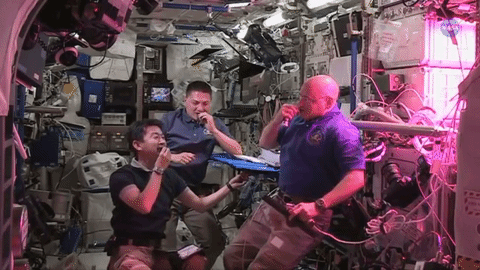
In a weightless environment, there is no up and down, so roots grow in all directions. Water and soil, the materials used to anchor these plants and allow for root growth tend to float away.
How Do We Grow Plants in Space?
1. Plant Pillows
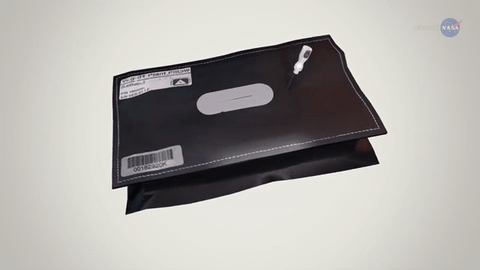
The Veggie chamber helps solve the problems of a weightless environment by using ‘plant pillows’, sounds comfy right? These pillows are bags filled with material for growing plants in space.
2. Wicks

Wicks are implanted into the bags and are used to draw water from inside the pillow to the plant.
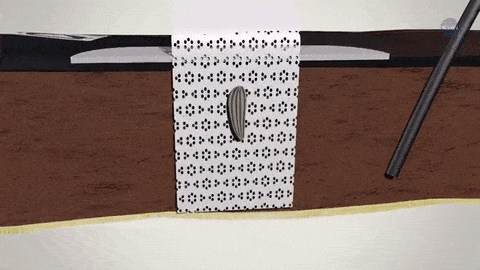
These wicks also provide a place to glue the seeds. It’s important to orient the seeds so roots will grow ‘down’, and shoots that emerge will push out of the bag.
3. LED Lights
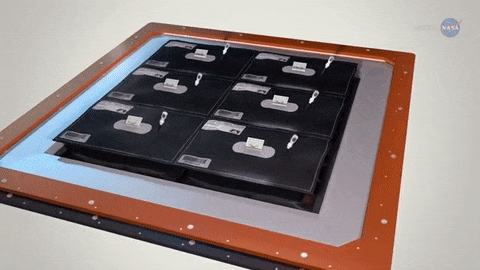
LED lights are used for photosynthesis and give the shoots a sense of direction so they keep growing upward. The walls of the Veggie chamber can expand to make room for the plant as it grows.
The purple/pinkish hue surrounding the plants in Veggie is the result of a combination of the red and blue lights, which is what the plants need to grow. Green LEDS were added so the plants look like edible food rather than weird purple plants.
Why are we growing plants in space?
When astronauts travel on deep space missions, like Mars, they will need to be self-sufficient for long periods of time. Having the ability to grow their own food is a big step in that direction. There is also a desire to grow flowering vegetables in space, which is why we are currently tending to zinnia flowers on orbit. Growing these flowering plants will help us understand longer duration growing plants that have to flower in space, such as tomatoes.
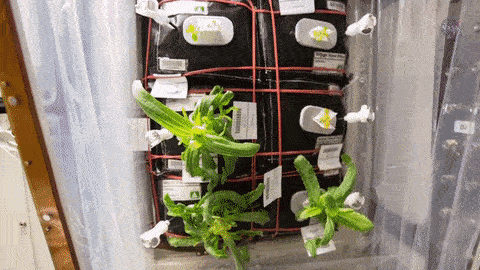
What’s Next? The next SpaceX delivery will include seeds for a small cabbage and additional red romaine lettuce. Upcoming experiments will use various ratios of red and blue lights and different fertilizers in attempts to improve crop yield, nutrition and flavor. The findings from these experiments can be utilized both on Earth and in space.
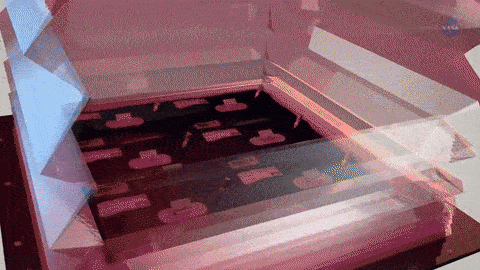
In addition to the nutrition benefits of growing vegetables in space, the psychological benefits are also significant. Having living plants can help with stress and increase the crews’ enjoyment. It provides the sights, smells and tastes of Earth.
To learn more about gardening in space, watch ScienceCast HERE.
Make sure to follow us on Tumblr for your regular dose of space: http://nasa.tumblr.com
Celebrating Spitzer, One of NASA’s Great Observatories
As the Spitzer Space Telescope’s 16-year mission ends, we’re celebrating the legacy of our infrared explorer. It was one of four Great Observatories – powerful telescopes also including Hubble, Chandra and Compton – designed to observe the cosmos in different parts of the electromagnetic spectrum.
Light our eyes can see
The part of the spectrum we can see is called, predictably, visible light. But that’s just a small segment of all the wavelengths of the spectrum. The Hubble Space Telescope observes primarily in the visible spectrum. Our Chandra X-ray Observatory is designed to detect (you guessed it) X-ray emissions from very hot regions of the universe, like exploded stars and matter around black holes. Our Compton Gamma Ray Observatory, retired in 2000, produced the first all-sky survey in gamma rays, the most energetic and penetrating form of light.

Then there’s infrared…
Infrared radiation, or infrared light, is another type of energy that we can't see but can feel as heat. All objects in the universe emit some level of infrared radiation, whether they're hot or cold. Spitzer used its infrared instrument to make discoveries in our solar system (including Saturn's largest ring) all the way to the edge of the universe. From stars being born to planets beyond our solar system (like the seven Earth-size exoplanets around the star TRAPPIST-1), Spitzer's science discoveries will continue to inspire the world for years to come.

Multiple wavelengths
Together, the work of the Great Observatories gave us a more complete view and understanding of our universe.

Hubble and Chandra will continue exploring our universe, and next year they’ll be joined by an even more powerful observatory … the James Webb Space Telescope!

Many of Spitzer's breakthroughs will be studied more precisely with the Webb Space Telescope. Like Spitzer, Webb is specialized for infrared light. But with its giant gold-coated beryllium mirror and nine new technologies, Webb is about 1,000 times more powerful. The forthcoming telescope will be able to push Spitzer's science findings to new frontiers, from identifying chemicals in exoplanet atmospheres to locating some of the first galaxies to form after the Big Bang.
We can’t wait for another explorer to join our space telescope superteam!
Make sure to follow us on Tumblr for your regular dose of space: http://nasa.tumblr.com
Download Software Used to Get Rovers to the Red Planet
Watching our Perseverance rover safely land on the surface of Mars is the kind of historic feat that gets our adventure-loving hearts racing.

Launching and landing rovers on Mars requires overcoming challenges like defying gravity on two planets, surviving the extreme heat of atmospheric entry, and avoiding rocky obstacles. This takes more than just rocket science – it takes incredible software too.
Did you know that some of the same tried and tested software that helped ensure a safe arrival for Perseverance (and its predecessor, Curiosity) can be downloaded – by you...for free...right now?

Our 2021-22 Software Catalog is full of codes made for space that can be used by entrepreneurs, teachers, gamers, or just about anyone. Whether you are curious about the Martian atmosphere, want to visualize the inside of a volcano, or have an application we’ve never even considered, our software may be able to help. Check out our full site, updated regularly with the latest codes available for download.
Here are a few examples of what you could do with our software!
1. Simulate the Martian atmosphere to prepare spacecrafts for landing

To prepare for exactly what a spacecraft will face on landing day, no matter the location scientists choose, we created software that simulates the Martian atmosphere. The code, Mars (GRAM), is now available to anyone.
We also have a version that simulates Earth's atmosphere, allowing users (especially those in the world of drone design) a way to replicate and design for, potentially dangerous conditions without ever stepping away from the computer.
2. Explore the Red Planet virtually from home with help from the Curiosity rover team
Originally developed for scientists and engineers working on the Curiosity rover mission, OnSight allowed the team a virtual way to walk on and look around Mars. Using an immersive display, such as a virtual reality headset, scientists could see the Red Planet the way a rover would.
This software can also be used to provide virtual experiences of places here on Earth, such as caves and lava fields.
3. Dodge disasters with a risk management tool made for space missions

When preparing for complex space missions, like the upcoming Mars Sample Return mission, it’s crucial to examine how different elements, independently and collectively, impact the probability of success.
But risk management has become an important tool for businesses of all disciplines, from engineering to accounting – and the Space Mission Architecture and Risk Analysis Tool (SMART) could help.
Sound interesting? The NASA software catalog has these and more than 800 additional codes ready for download.
You can also follow our Technology Transfer program on Twitter to learn more about software and technology that can be put to use on Earth.
Make sure to follow us on Tumblr for your regular dose of space!

Hello! @Astro_Jessica here ready to take your @nasa questions! @sxsw
May the Four Forces Be With You!
May the force be with you? Much to learn you still have, padawan. In our universe it would be more appropriate to say, “May the four forces be with you.”
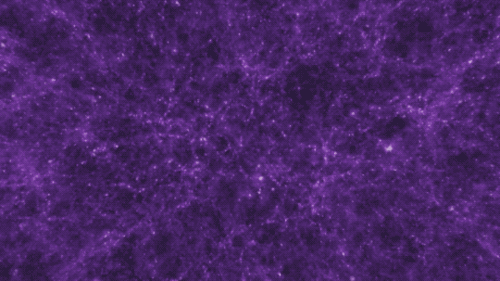
There are four fundamental forces that bind our universe and its building blocks together. Two of them are easy to spot — gravity keeps your feet on the ground while electromagnetism keeps your devices running. The other two are a little harder to see directly in everyday life, but without them, our universe would look a lot different!
Let’s explore these forces in a little more detail.
Gravity: Bringing the universe together

If you jump up, gravity brings you back down to Earth. It also keeps the solar system together … and our galaxy, and our local group of galaxies and our supercluster of galaxies.
Gravity pulls everything together. Everything, from the bright centers of the universe to the planets farthest from them. In fact, you (yes, you!) even exert a gravitational force on a galaxy far, far away. A tiny gravitational force, but a force nonetheless.

Credit: NASA and the Advanced Visualization Laboratory at the National Center for Supercomputing and B. O'Shea, M. Norman
Despite its well-known reputation, gravity is actually the weakest of the four forces. Its strength increases with the mass of the two objects involved. And its range is infinite, but the strength drops off as the square of the distance. If you and a friend measured your gravitational tug on each other and then doubled the distance between you, your new gravitational attraction would just be a quarter of what it was. So, you have to be really close together, or really big, or both, to exert a lot of gravity.
Even so, because its range is infinite, gravity is responsible for the formation of the largest structures in our universe! Planetary systems, galaxies and clusters of galaxies all formed because gravity brought them together.
Gravity truly surrounds us and binds us together.
Electromagnetism: Lighting the way
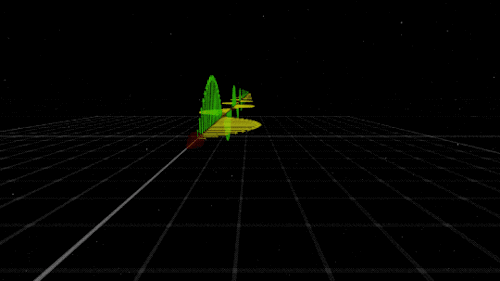
You know that shock you get on a dry day after shuffling across the carpet? The electricity that powers your television? The light that illuminates your room on a dark night? Those are all the work of electromagnetism. As the name implies, electromagnetism is the force that includes both electricity and magnetism.
Electromagnetism keeps electrons orbiting the nucleus at the center of atoms and allows chemical compounds to form (you know, the stuff that makes up us and everything around us). Electromagnetic waves are also known as light. Once started, an electromagnetic wave will travel at the speed of light until it interacts with something (like your eye) — so it will be there to light up the dark places.

Like gravity, electromagnetism works at infinite distances. And, also like gravity, the electromagnetic force between two objects falls as the square of their distance. However, unlike gravity, electromagnetism doesn't just attract. Whether it attracts or repels depends on the electric charge of the objects involved. Two negative charges or two positive charges repel each other; one of each, and they attract each other. Plus. Minus. A balance.
This is what happens with common household magnets. If you hold them with the same “poles” together, they resist each other. On the other hand, if you hold a magnet with opposite poles together — snap! — they’ll attract each other.
Electromagnetism might just explain the relationship between a certain scruffy-looking nerf-herder and a princess.
Strong Force: Building the building blocks

Credit: Lawrence Livermore National Laboratory
The strong force is where things get really small. So small, that you can’t see it at work directly. But don’t let your eyes deceive you. Despite acting only on short distances, the strong force holds together the building blocks of the atoms, which are, in turn, the building blocks of everything we see around us.
Like gravity, the strong force always attracts, but that’s really where their similarities end. As the name implies, the force is strong with the strong force. It is the strongest of the four forces. It brings together protons and neutrons to form the nucleus of atoms — it has to be stronger than electromagnetism to do it, since all those protons are positively charged. But not only that, the strong force holds together the quarks — even tinier particles — to form those very protons and neutrons.
However, the strong force only works on very, very, very small distances. How small? About the scale of a medium-sized atom’s nucleus. For those of you who like the numbers, that’s about 10-15 meters, or 0.000000000000001 meters. That’s about a hundred billion times smaller than the width of a human hair! Whew.
Its tiny scale is why you don’t directly see the strong force in your day-to-day life. Judge a force by its physical size, do you?
Weak Force: Keeping us in sunshine

If you thought it was hard to see the strong force, the weak force works on even smaller scales — 1,000 times smaller. But it, too, is extremely important for life as we know it. In fact, the weak force plays a key role in keeping our Sun shining.
But what does the weak force do? Well … that requires getting a little into the weeds of particle physics. Here goes nothing! We mentioned quarks earlier — these are tiny particles that, among other things, make up protons and neutrons. There are six types of quarks, but the two that make up protons and neutrons are called up and down quarks. The weak force changes one quark type into another. This causes neutrons to decay into protons (or the other way around) while releasing electrons and ghostly particles called neutrinos.
So for example, the weak force can turn a down quark in a neutron into an up quark, which will turn that neutron into a proton. If that neutron is in an atom’s nucleus, the electric charge of the nucleus changes. That tiny change turns the atom into a different element! Such reactions are happening all the time in our Sun, giving it the energy to shine.
The weak force might just help to keep you in the (sun)light.

All four of these forces run strong in the universe. They flow between all things and keep our universe in balance. Without them, we’d be doomed. But these forces will be with you. Always.
You can learn more about gravity from NASA’s Space Place and follow NASAUniverse on Twitter or Facebook to learn about some of the cool cosmic objects we study with light.
Make sure to follow us on Tumblr for your regular dose of space: http://nasa.tumblr.com
-
 donut-call-me-at-all liked this · 2 years ago
donut-call-me-at-all liked this · 2 years ago -
 nikolaiinthecellar liked this · 3 years ago
nikolaiinthecellar liked this · 3 years ago -
 maxim008 liked this · 3 years ago
maxim008 liked this · 3 years ago -
 jorgiop liked this · 3 years ago
jorgiop liked this · 3 years ago
Explore the universe and discover our home planet with the official NASA Tumblr account
1K posts